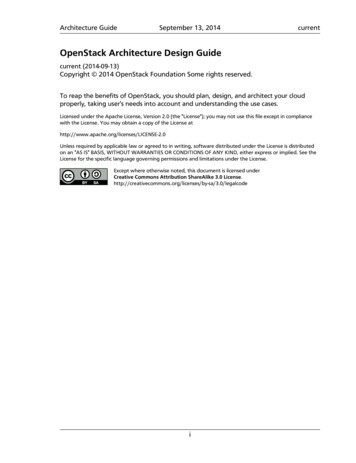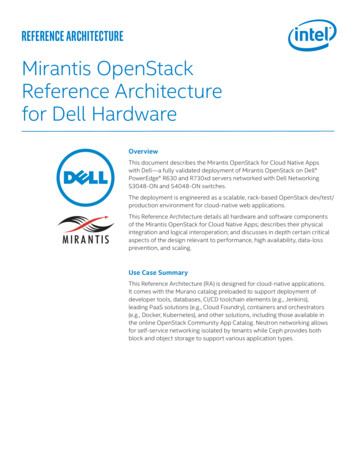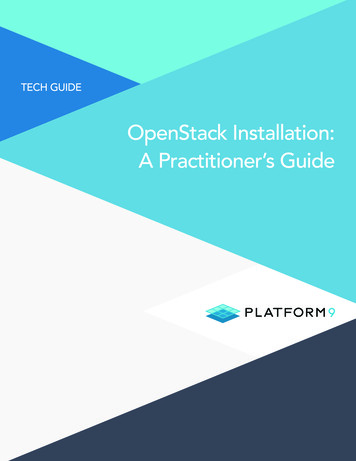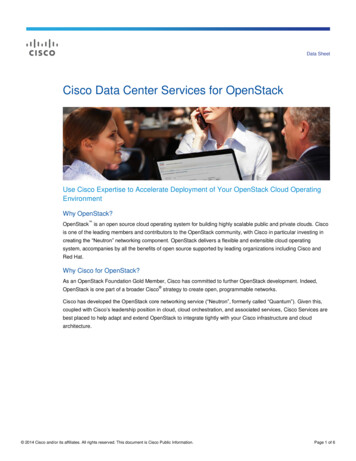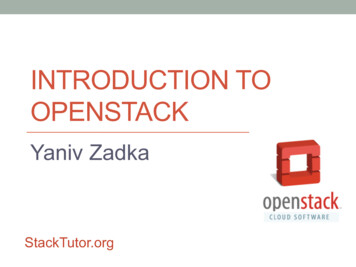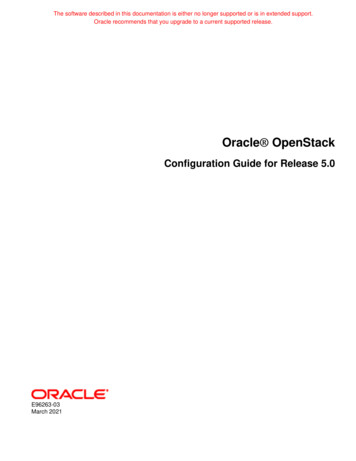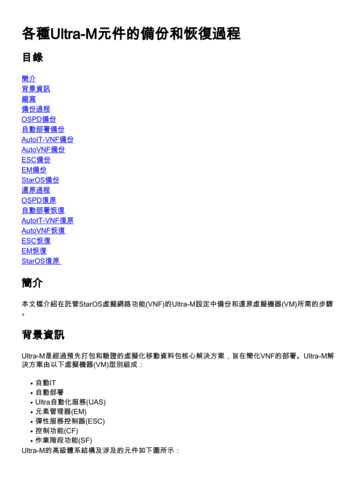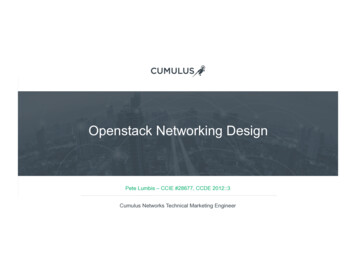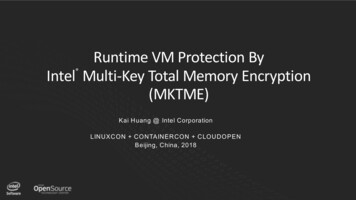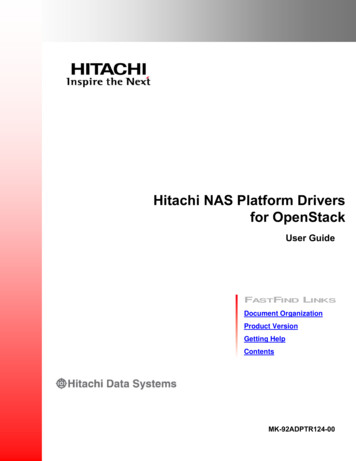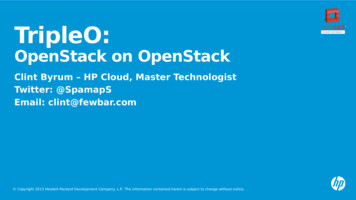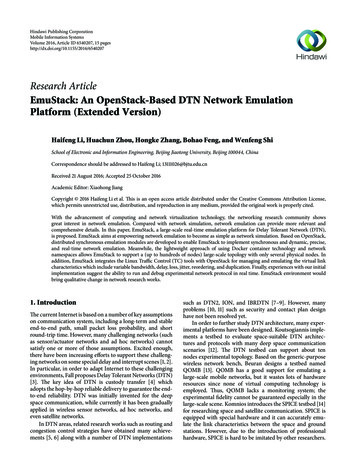
Transcription
Hindawi Publishing CorporationMobile Information SystemsVolume 2016, Article ID 6540207, 15 h ArticleEmuStack: An OpenStack-Based DTN Network EmulationPlatform (Extended Version)Haifeng Li, Huachun Zhou, Hongke Zhang, Bohao Feng, and Wenfeng ShiSchool of Electronic and Information Engineering, Beijing Jiaotong University, Beijing 100044, ChinaCorrespondence should be addressed to Haifeng Li; 13111026@bjtu.edu.cnReceived 21 August 2016; Accepted 25 October 2016Academic Editor: Xiaohong JiangCopyright 2016 Haifeng Li et al. This is an open access article distributed under the Creative Commons Attribution License,which permits unrestricted use, distribution, and reproduction in any medium, provided the original work is properly cited.With the advancement of computing and network virtualization technology, the networking research community showsgreat interest in network emulation. Compared with network simulation, network emulation can provide more relevant andcomprehensive details. In this paper, EmuStack, a large-scale real-time emulation platform for Delay Tolerant Network (DTN),is proposed. EmuStack aims at empowering network emulation to become as simple as network simulation. Based on OpenStack,distributed synchronous emulation modules are developed to enable EmuStack to implement synchronous and dynamic, precise,and real-time network emulation. Meanwhile, the lightweight approach of using Docker container technology and networknamespaces allows EmuStack to support a (up to hundreds of nodes) large-scale topology with only several physical nodes. Inaddition, EmuStack integrates the Linux Traffic Control (TC) tools with OpenStack for managing and emulating the virtual linkcharacteristics which include variable bandwidth, delay, loss, jitter, reordering, and duplication. Finally, experiences with our initialimplementation suggest the ability to run and debug experimental network protocol in real time. EmuStack environment wouldbring qualitative change in network research works.1. IntroductionThe current Internet is based on a number of key assumptionson communication system, including a long-term and stableend-to-end path, small packet loss probability, and shortround-trip time. However, many challenging networks (suchas sensor/actuator networks and ad hoc networks) cannotsatisfy one or more of those assumptions. Excited enough,there have been increasing efforts to support these challenging networks on some special delay and interrupt scenes [1, 2].In particular, in order to adapt Internet to these challengingenvironments, Fall proposes Delay Tolerant Networks (DTN)[3]. The key idea of DTN is custody transfer [4] whichadopts the hop-by-hop reliable delivery to guarantee the endto-end reliability. DTN was initially invented for the deepspace communication, while currently it has been graduallyapplied in wireless sensor networks, ad hoc networks, andeven satellite networks.In DTN areas, related research works such as routing andcongestion control strategies have obtained many achievements [5, 6] along with a number of DTN implementationssuch as DTN2, ION, and IBRDTN [7–9]. However, manyproblems [10, 11] such as security and contact plan designhave not been resolved yet.In order to further study DTN architecture, many experimental platforms have been designed. Koutsogiannis implements a testbed to evaluate space-suitable DTN architectures and protocols with many deep space communicationscenarios [12]. The DTN testbed can support about tennodes experimental topology. Based on the generic-purposewireless network bench, Beuran designs a testbed namedQOMB [13]. QOMB has a good support for emulating alarge-scale mobile networks, but it wastes lots of hardwareresources since none of virtual computing technology isemployed. Thus, QOMB lacks a monitoring system; theexperimental fidelity cannot be guaranteed especially in thelarge-scale scene. Komnios introduces the SPICE testbed [14]for researching space and satellite communication. SPICE isequipped with special hardware and it can accurately emulate the link characteristics between the space and groundstations. However, due to the introduction of professionalhardware, SPICE is hard to be imitated by other researchers.
2Meanwhile, without using network virtualization technology,the emulation topology of SPICE is fixed and will be changeddifficultly.With the advancement of network and compute virtualization technology, it becomes much easier to designand implement a scalable and flexible emulation platformthan before. In this work, EmuStack, a network emulationplatform for DTN, is introduced. Our design objective isenabling EmuStack to support a large-scale, real-time, anddistributed network emulation and provide synchronousand dynamical precise management for topology and linkcharacteristics. For example, Docker container technology[15] is utilized as the compute virtualization technique intoefficiently virtualize several physical emulation nodes intohundreds of virtual emulation nodes. By integrating LinuxTraffic Control (TC) utility [16] with OpenStack [17], EmuStack can achieve more fine-grained control of the virtualtopology and link characteristics. Meanwhile, OpenStack iscomposed of various independent modules; thus it possessesa good support for the development of the other functionalities in EmuStack. To improve the performance of EmuStack,many OpenStack subprojects are adopted. An example isCeilometer [18] which is developed lightly and integrated intoEmuStack for ensuring experimental fidelity and monitoring,alarming, and collecting relevant data.As we have a deeper insight into our initial work [19],in this paper, we further present details of controlling linkcharacteristics and analyze the reason for link rate-limitingdifference between the Ethernet device of virtual emulationnode and the TAP device of physical emulation node.Moreover, we further introduce EmuStack scalability andperformance and discuss their main factors. Additionally, weprovide one more DTN experiment to better evaluate anddemonstrate the performance of EmuStack.The remainder of this paper is organized as follows.In Section 2 we introduce the related work. In Sections 3and 4, we present architectural design, implementation ofEmuStack and thoroughly discuss performance of EmuStack.Then we reproduce two published classic DTN experimentsand compare and analyze the key experimental results inSection 5. Finally, in Section 6, we conclude this paper alongwith future works.2. Related WorkRecently, with the advancement of container virtualization technology, network researchers show their interest inemploying container to construct their experimental platforms to support their large-scale topology experiments.Emulab [20] is one of the well-known testbeds using thecontainer virtualization in Linux. Due to the efficiency ofcontainer, Emulab possesses a good support for scalability.Although these technologies introduced in Emulab are notthe latest now, the design philosophies are still helpful forcurrent researchers to design large-scale test bed. Additionally, Lantz et al. [21] designed Mininet based on containervirtualization technique including processes and networknamespaces technique. Mininet can support SDN and runon a single computer. Handigol et al. [22] further improvedMobile Information SystemsMininet performance with enhancements to resource provisioning, isolation, and monitoring system. Besides, Handigolreplicated a number of previously published experimentalresults and proved that Linux Container (LXC) [23] technology is not only lightweight but also possesses a goodfidelity and performance. In order to perform an in-depthperformance evaluation of LXC, Xavier et al. [24] conducted anumber of experiments to evaluate various compute virtualization technologies and finally proved that LXC virtualizationhas a near-native performance on CPU, memory, disk, andnetwork. Therefore, in EmuStack, we employ Docker container (based on LXC) as compute virtualization technology.OpenStack is an open-source reference frameworkmainly for developing private and public cloud, which consists of loosely-coupled components that can control hardware pools of compute, network, and storage resources.OpenStack is composed of many different independentmodules, and anyone can add additional components intoOpenStack to meet their requirements. Therefore, OpenStackis definitely a good choice for developing emulation platform.3. Architectural DesignThis section describes the overall architecture design ofEmuStack from the perspective of hardware and software.3.1. Hardware. Figure 1 shows EmuStack hardware structure(where gray rectangles stand for primary services installed).EmuStack hardware can be composed of only several physicalnodes (general-purpose computer). There are two types ofphysical nodes: network emulator and physical emulationnodes. Network emulator is the core hardware which is aphysical node equipped with multiple NICs in EmuStack andit plays multiple roles. It is not only an OpenStack controllernode which manages compute and network resources and anOpenStack network node which manages virtual emulationnetworks, but also an emulation orchestrator which is responsible for creating emulation parameters and orchestrating thewhole resources of CPU, memory, and network. In addition,physical emulation node is a compute node of OpenStack,which hosts all virtual emulation nodes and executes theemulation control commands from network emulator.In EmuStack, there are two types of physical networks,namely, the management network and emulation network.Management network carries management traffic which consists of lightweight control information and usually does notbecome the determinant of performance. Emulation networktransfers emulation data which consumes much bandwidthand would vary greatly with different DTN protocol experiments. Therefore, the physical emulation network possiblybecomes the main limitation of EmuStack. For several physical nodes system of EmuStack, adopting the star structure cansolve the emulation data traffic bottleneck problem, as shownin the bottom right of Figure 1. In this structure, all emulationNICs of physical emulation nodes are directly connected tothose of network emulator. NICs of network emulator areattached to an Open vSwitch bridge, where the “internal”device named after itself is assigned an IP address belongingto the emulation network. In practice, this physical emulation
Mobile Information Systems3SwitchManagement networkEmulation nodes···Network emulatorNova-ComputeNova-ComputeOpen vSwitch agentOpen vSwitch agentNetem agentNetem agentCompute nodeCompute nodeNeutron-NetemserviceNeutron-l3 agentNeutron-dhcpagentNetwork nodeEmulation nodesMYSQL serverRABBITMQ serverNova APINova-schedulerNova conductorKeystone-allNova-ComputeOpen vSwitch agentNova-ComputeNetem agentOpen vSwitch agentNetem agentCompute nodeCompute node···Neutron serverGlance APIGlance registryController nodeEmulation networkEmulation nodeNetwork emulatorEmulation physical topologyFigure 1: EmuStack hardware structure.network structure can meet most requirements of our DTNresearch works; however if researchers want to construct theEmuStack system that consists of dozens of physical nodes,this structure would become infeasible since network emulator would not have enough NICs to directly connect to allthe emulation NICs of physical emulation nodes. For systemwith dozens of physical nodes, physical emulation networkcan employ several physical switches to carry the emulationdata as management network does. In this scheme, as thefirst step, we need to determine which one of physical NICson network emulator (and physical emulation nodes) willcarry management traffic. Then we connect all the remainingNICs of network emulator (and physical emulation nodes)to those physical switches. Those physical switches portswill need to be specially configured to allow trunked orgeneral traffic. Finally, for EmuStack system with hundredsof physical nodes, as a part of the future work, we willextend network emulator to support distributed processingand enable multiple network emulators to exist in EmuStack.3.2. Software. Figure 2 describes EmuStack software synopsisinvolving network emulator, physical emulation node, andvirtual emulation node. As the key component of EmuStack,network emulator carries many open-source services andcustomized service extensions. Nova service and the coreplugin in Neutron service is attended to initialize virtualemulation nodes and virtual emulation network, respectively.Additionally, these services also have the ability to create,modify, and delete virtual emulation nodes and virtualemulation network. Neutron-Netem service is responsible forgenerating experimental parameters and data to dynamicallycontrol experimental program, topologies, and link characteristics. Meanwhile, in order to provide sufficient fidelity andreduce experimental complexity at the same time, we adoptTelemetry Management (Ceilometer) [18] service to monitorand collect hardware resources and experimental data. Inaddition, Keystone [25], Horizon [26], and Glance [27] areutilized to provide the support for managing authentication,authorization, service catalog, web interface, and imageservices. Besides, as a part of the future work, on the basis ofOpenStack Heat service, we will develop the orchestrator tomore efficiently and flexibly orchestrate the distributed hardware resource management [28]. Most of those services areopen-source projects and available in OpenStack; hence weonly need to integrate them to meet most EmuStack designrequirements. In order to implement synchronous, dynamic,precise, and real-time emulation control service, we designand implement the Neutron-Netem service and NeutronNetem agent, which will be further discussed in Section 4.As shown in the bottom left of Figure 2, physical emulation node is regarded as a compute node in OpenStackwhere virtual emulation nodes are hosted. Physical emulationnode runs Nova-Compute service driven by the Dockerhypervisor to manage virtual emulation nodes and OpenvSwitch agent to execute the managing emulation networkcommands (including create, modify, and delete function)from network emulator. Open vSwitch agent employs twoOpen vSwitch (OVS), “OVS for emulation” and “OVS for
4Mobile Information SystemsVirtual emulation nodeNetwork emulatorOrchestratorHeatPuppet clientNovaProtocol TPCore plugin(initial topology, QoSby open vSwitch)Neutron-Netem service(dynamic topology,link characteristics)rknetwoationlumEPhysical emulation nodeNeutron-Netem agentOpen vSwitch agentNTPDockerNova-ComputeTelemetry agentVENVENVENVENVENEmulation virtual topologyVENVEN: virtual emulation nodeOVS for emulationOVS for controlkwort netneagemManSwitchPCFigure 2: Synopsis of EmuStack software.control” to manage virtual emulation networks and virtualmanagement networks, respectively. Open vSwitch agentsmanage virtual networks by configuring flow rules on theabove two OVS. Moreover, as the agent of Ceilometer servicein network emulator, Telemetry Agent is responsible for publishing collected data to network emulator through the management network and creating alarms once collected databreaks the monitoring rules. Finally, Neutron-Netem agentis designed to precisely and dynamically control emulationtopologies and link characteristics, which will be furtherintroduced in Section 4.As shown in the upper left of Figure 2, virtual emulationnode (VEN) is a Docker virtual machine which is hosted inphysical emulation node. It is spawned from the operatingsystem image where Network Time Protocol (NTP) service,custom network protocol software, and Puppet client servicecan be installed. In particular, Puppet client service can be utilized by virtual emulation nodes to receive control information from network emulator or physical emulation nodes.Note that time synchronization is very essential forEmuStack. The DTN bundle protocol depends on absolutetime to determine whether received packets are expired. Furthermore, EmuStack must ensure the experimental programin different virtual emulation nodes which can be exactly synchronously executed in the correct time sequences. Therefore,Chrony [29], an implementation of NTP [30], is installed inall nodes to provide the properly synchronizing services. Indetail, network emulator is configured to reference accuratetime servers while physical and virtual emulation nodes referto network emulator. In our local area network (LAN) ofEmuStack, the time synchronization precision reaches as highas 0.1 milliseconds, which meets the requirements for mostemulation experiments.4. ImplementationThis section describes the details of EmuStack core modules(Neutron-Netem service and Neutron-Netem agent). Firstly,in order to sketch the outline of EmuStack implement, EmuStack emulation workflow is described in Section 4.1. Secondly,Sections 4.2, 4.3, and 4.4 present the details of emulationsynchronous control, topology control, and customization of
Mobile Information SystemsOrchestrator5Neutron serverML2-OVS pluginGUI/CLIPhysical emulation L2-OVS agentL2-OVS driverStorageNeutron-NetemdriverNetwork-create requestInitializes topology MESSAGE RPC Network-create responseEmulation-data-create requestCreates and storesemulation dataTransmits emulation configurationand data to each physical nodesStores configurationand data MESSAGE RPC RESTFUL API Adds rules for interface tobr-int and br-tun/br-ethxEmulation-data-create responseTransmits emulation configurationto virtual emulation nodesEmulation-run requestGenerates absolute timestamp to start emulationEmulation-run(finish) responseEmulation loop,absolute time controlRuns experiment software,controls topology and linkcharacteristics on virtualemulation nodesFigure 3: Process flow of emulation network.link characteristics, respectively. Finally, the scalability andperformance of EmuStack are discussed in Section 4.5.4.1. Emulation Workflow. Before the beginning of emulation,we first create a virtual machine image, where specialsoftware and shell scripts should be installed to fulfill thespecific experimental requirements. For example, you mustinstall an SSH server (or Puppet client) into the image andensure that it starts up on boot with the correct configuration,or you may install shell scripts to collect some experimentresults. Next, we create virtual networks before launchingvirtual emulation nodes. Virtual networks are composed oftwo types of networks, namely, management network andemulation network. Management network is Neutron flatnetwork in OpenStack, where all nodes (including virtual,physical emulation nodes, and network emulator) reside onthe same network and no VLAN tags are created. Emulationnetwork involves one or more private virtual networks.Moreover, one virtual emulation node could belong to eitherone or more virtual emulation networks. After creatingvirtual network, we launch a sufficient number of virtualemulation nodes and initialize virtual networks, right beforerunning the emulation.Unlike a simulator running in virtual time based ondiscrete event, EmuStack runs in real time and cannot pausea node’s clock to pend for events. For a distributed real-timeemulation platform, it is difficult to ensure that every controlcommand can be executed synchronously in the differentphysical nodes due to the stochastic communication delayand background system load. In order to avoid communication delay, especially the control information transmissiondelay, EmuStack stores the control information in the localstorage before emulation starts to run.We can now introduce the process flow of emulationnetwork described in Figure 3. Note that the ML2-OVSplugin, L2-OVS agent, and L2-OVS driver are componentsof the core plugin in Neutron service. As with OpenStack,EmuStack firstly initializes emulation topology by launchinginstances together. Secondly, after a successful initialization,the orchestrator requests Neutron-Netem service to run
6mobility module to create topology and link characteristicsdata. Meanwhile, in order to support the requirements ofthose who evaluate the same experimental protocol withdifferent protocol parameters and the same model data,Neutron-Netem service stores the generated model data inthe persistent storage. Thirdly, Neutron-Netem service dispatches the emulation data to each agent residing in everyphysical emulation node. The emulation data is split into different parts for each agent and every agent just only receivesits own part and stores it. Relatively, every agent can transmit experimental configuring parameters to virtual emulation nodes by invoking Puppet server API. In each virtualemulation node, Puppet client works in kick-mode and startsto receive configuration (or command) once triggered byNeutron-Netem agent. Finally, after dispatching the emulation data, the orchestrator sends a request to Neutron-Netemservice to start emulation; then Neutron-Netem servicedelivers an absolute timestamp to every agent. Once thestaring time is up, agents will start to emulate the experiment,and therefore, the starting timestamp has to be a little (such assixty seconds) larger than current timestamp, and that extratime is left for Neutron-Netem agents receiving the startingtimestamp.In EmuStack, Neutron-Netem service is organized intoseparate submodules such as storage and mobility modules.In particular, Neutron-Netem service provides a simple plugin mechanism to enable users to extend different mobilitymodules. Thus mobility modules can be individually built asresearchers’ own experimental purposes. The various mobility modules are intended to provide required realistic network emulation environment for different experimental network protocol development. Besides, Neutron-Netem serviceprovides the inheritance mechanism that a mobility modulecan be developed based on the others. The primary functionality of a mobility module is to create data for dynamicallycontrolling emulation topology and link characteristics. InSection 5, we will employ two mobility modules for DTNlarge file transmission experiment and the DTN routingprotocol comparison experiment of Probabilistic Routingwith Epidemic, respectively.4.2. Synchronous Control. Algorithm 1 describes the synchronous control of Neutron-Netem agent. As shown inlines (2) to (4), Neutron-Netem agents all are asleep andsynchronously start emulation once the starting time comes.The time synchronization accuracy depends on the sleepingtime SLEEP TIME and the NTP synchronization precision.Since the NTP synchronization precision is as high as 0.1milliseconds in our platform environment, the synchronization accuracy is only up to SLEEP TIME. In fact, theSLEEP TIME is a trade-off between synchronization precision and system load. In practice, we set SLEEP TIME to 100(milliseconds) to satisfy the requirements of most experimentwith lightweight CPU load.With the coming of starting time, Algorithm 1 goes intothe outer loop as shown in lines (11) to (23). This outer looptakes advantage of absolute time to control its cycles. Asshown in line (13), LOOP CYCLE (loop cycle) is an important parameter for this loop system. The topology and linkMobile Information Systems(1) INIT protocol software(2) WHILE current time starting time(3)sleep SLEEP TIME miliseconds(4) END WHILE(5)(6) INIT topology control(7) INIT link characteristics control(8) START state collection(9)(10) SET counter to 0(11) WHILE counter CONTROL PERIOD(12) increment counter(13) next time start time \LOOP CYCLE counter(14) control topology(15) control link characteristics(16) control protocol software(17) IF current time – next time THRESHOLD(18)collect error log(19) END IF(20) WHILE current time next time(21)sleep SLEEP TIME miliseconds(22) END WHILE(23) END WHILE(22) KILL all experiment processesAlgorithm 1: Synchronous control on Neutron-Netem agent.characteristics are updated every LOOP CYCLE. The controloperation delay (lines (14) to (16)) plus sleeping time (lines(20) to (22)) is around equal to LOOP CYCLE. However,due to system load and other unknown factors, the controloperation delay may be larger than LOOP CYCLE by accident; this will lead to synchronous control failure. To helpusers evaluate the fidelity of the experiments, this failureinformation all is logged (lines (17) to (19)). Besides, theexceeded time will force future cycles of the loop to reducethe sleeping time; this will enable platform to synchronizeagain. After the end of outer loop, Neutron-Netem agents killall experiment processes to get ready for next experiment.4.3. Controlling Topology. Figure 4 provides details on thecontrolling topology and link characteristics. As shown in theright of Figure 4, Neutron-Netem service delivers the controlinformation to Neutron-Netem agents in advance. Accordingto the received control information, Neutron-Netem agentsinvoke their driver to dynamically control the emulationexperiment once the starting time is coming. In particular,as a part of this control information, the topology controlinformation is described by connection matrix in EmuStack,as shown in Figure 5. In fact, a network topology, no matterhow complex it is, can be represented by a connectingrelationship between any two nodes. An example for a threenodes topology is shown in Figure 5, where “1” corresponds toconnection between two nodes and “0” means disconnection.In EmuStack, the connection matrix along with timesequences is generated by mobility module. Accordingto connection matrix, Neutron-Netem agents periodically
Mobile Information Systems7Network emulatorA named network namespace,corresponding to a virtual emulationNeutron APInode, is configured by Neutron-Netem agentStorageModular layer 2Neutron-Netem serviceTC structure diagramconfigured by Neutron-Netem agentFirst locationDelivers the control information1:Root1:1HTBPhysical emulation nodeVENNeutron-Netem FilterNamespaceTAPHTBTAPHTBHTBConfigures flow tablesOVS for emulationOVS for controleth0eth1110:200:1000:NetemNetemNetemSecond locationFigure 4: Topology and link characteristics control.N2N3N1N2N3N1110N2110N3101N1Figure 5: Simple topology and connection matrix.invoke their drivers to dynamically change emulation topology during the emulation. There are two ways to dynamically controlling emulation topology: one is based on OpenvSwitch and the other is to depend on iptables. NeutronNetem agents can control virtual emulation topology byconfiguring flow tables on “OVS for emulation.” Managingvirtual emulation topology in this way is similar to howNeutron-Open vSwitch agent manages virtual topology inOpenStack, but Neutron-Netem agents can do these moreefficiently and quickly. Meanwhile, Neutron-Netem agentscan achieve higher synchronous precision since they havealready store the emulation control information into localstorage, while Neutron-Open vSwitch needs to get this control information by Remote Procedure Call (RPC) serviceswhich take a long-term delay. Additionally, Neutron-Netemagents can dynamically control virtual emulation topologyby configuring iptables entries in the special named networknamespace. This namespace is corresponding to the virtualemulation node as shown in the top right of Figure 4. In theinitial implement of EmuStack, the second way to controltopology is implemented in Neutron-Netem agent driver,whose performance will be discussed in Section 4.5. As to thefirst method, we would take it into consideration in the futurework.4.4. Controlling Link Characteristics. In Linux, system offersa very rich set of tools for traffic control. The Traffic Control,TC, utility is one of the most famous tools. TC is goodat shaping link characteristics which include link bandwidth, latency, jitter, packet loss, duplication, and reordering.Besides, it allows users to set queuing disciplines (QDiscs)within network namespace. There are two types of QDiscsin TC: one is classful queuing disciplines which have filtersattached to them and allow traffic to be directed to particularclassed queues or subqueues; the other is classless queuingdisciplines which can be used as primary QDiscs or insidea leaf class of a classful QDiscs. As shown in the bottomright of Figure 4, Hierarchical Token Bucket (HTB) [31] isclassful QDiscs, and Netem [32] is classless. In EmuStack,
8Mobile Information SystemsHost ASwitch BXbzero(buffer, MAXSIZE);while ( fread(buffer) 0 ) {send(buffer);bzero(buffer, MAXSIZE);Y}Simple physical topologySending program in host ADetails of sending programUser spaceBufferr)ffeud(bSenSocket APIckdbaFeeFeedbaNetfilter(iptables)ck Traffic controlSocket bufferdev queue xmitTCKernel spacehard start xmitOverflowNIC driverYXForwardFigure 6: Rate-limiting difference between two locations.Neutron-Netem agents use HTB to control link rate, attaching filters to HTB QDiscs to distinguish different virtualemulation links. Meanwhile, Netem is used inside HTBleaf classes to emulate variable delay, loss, reordering, andduplication.In telecommunications, a link is a communication channel that connects two communicating devices (such asnetwork interfaces); a media access control address (MACaddress) is a unique identifier assigned to network interfacefor communications. Hence, in EmuStack, we can use sourcedestination MAC addresses to configure filter rules to distinguish different virtual emulation links. In particular, dueto the high link asymmetry in most DTN experiments,EmuStack adopts the source-destination ordered pairs to distinguish the difference between uplink and downlink. Meanwhile, we elaborately design control policies since TC QDiscsare only good at shaping o
EmuStack: An OpenStack-Based DTN Network Emulation Platform (Extended Version) fengShi School of Electronic and Information Engineering, Beijing Jiaotong University, Beijing , China Correspondence should be addressed to Haifeng Li;@b jtu.edu.cn
